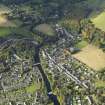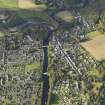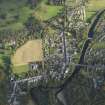Pricing Change
New pricing for orders of material from this site will come into place shortly. Charges for supply of digital images, digitisation on demand, prints and licensing will be altered.
Comrie, Dalginross Bridge
Road Bridge (20th Century)
Site Name Comrie, Dalginross Bridge
Classification Road Bridge (20th Century)
Alternative Name(s) River Earn; Comrie Bridge
Canmore ID 24852
Site Number NN72SE 38
NGR NN 77365 21912
Datum OSGB36 - NGR
Permalink http://canmore.org.uk/site/24852
- Council Perth And Kinross
- Parish Comrie (Perth And Kinross)
- Former Region Tayside
- Former District Perth And Kinross
- Former County Perthshire
NN72SE 38 77365 21912
Dalginross Bridge [NAT]
OS 1:10,000 map, 1978.
This steel girder road bridge over the River Earn at Comrie was designed and built by Sir William Arrol and Company Limited in 1904. The bridge is some 200 ft long with a centre span of 90 ft, the two side spans being 55 ft in length. It is of unusual design known as 'Constrained Cantilevers', the cantilevers meeting at the centre of the span and connected by a pendulum link. The piers and abutments are of sandstone, the river piers being founded on caissons 25.5ft in length, 6ft in width and 10ft in depth. The bridge sits on four main girders and the walkways are on cantilevered brackets. Local authority requirements conditioned its design.
Sir William Arrol and Company 1909; J R Hume 1977.
(Location cited as NN 773 219). Dalginross Bridge, built 1904, engineers Sir William Arrol and Co. A three-span steel girder bridge with two double cantilevers supported on masonry piers. The first 'constrained' cantilever bridge in Britain, its design was conditioned by local authority requirements as to loading and overall height, and by aesthetic considerations. Overall length 200ft (61m).
J R Hume 1977.
Dalginross Bridge was given the 2001 conservation commendation award by the Saltire Society's Civil Engineering Award Committee. The bridge has been strengethened by 'the seeding in' of additional girders without loss of appearance.
Institution of Civil Engineers, PHEW Newsletter, Issue 93 (March 2002), 3
This bridge carries the B827 public road over the River Earn between the villages of Comrie (NN72SE 64) and Dalginross (NN72SE 65), to the N and S respectively. It thus forms a southwards continuation of Bridge Street, Comrie.
The location assigned to this record defines the approximate midpoint of the span. The available map evidence suggests that it extends from NN c. 77372 21892 to NN c. 77355 21935.
Information from RCAHMS (RJCM), 25 May 2006.
Construction (1904 - 1905)
This three-span steel cantilever bridge was erected over the Earn from 1904–05, the first of its kind in Britain.
R Paxton and J Shipway 2007
Reproduced from 'Civil Engineering heritage: Scotland - Lowlands and Borders' with kind permission from Thomas Telford Publishers.
Publication Account (1909)
This steel girder road bridge over the River Earn at Comrie was designed and built by Sir William Arrol and Company Limited in 1904. The bridge is some 200 ft long with a centre span of 90 ft, the two side spans being 55 ft in length. It is of unusual design known as 'Constrained Cantilevers', the cantilevers meeting at the centre of the span and connected by a pendulum link. The piers and abutments are of sandstone, the river piers being founded on caissons 25.5ft in length, 6ft in width and 10ft in depth. The bridge sits on four main girders and the walkways are on cantilevered brackets. Local authority requirements conditioned its design.
Sir William Arrol and Company, 1909; J R Hume 1977.
Project (2007)
This project was undertaken to input site information listed in 'Civil engineering heritage: Scotland - Lowlands and Borders' by R Paxton and J Shipway, 2007.
Publication Account (2007)
This three-span steel cantilever bridge was erected over the Earn from 1904–05, the first of its kind in Britain. It is 200 ft long with two anchor spans of 52 ft each and a cantilevered centre span of 86 ft and contains 182 tons of steel. The interest lies in two arms of the cantilevered centre span, which meet at a pin-joint at mid-span, without the more usual suspended span joining their ends. This form gives maximum slenderness at mid-span, and offers a convenient location for a movement joint.
The construction is of four tapering plate-girders carrying the roadway, with footways cantilevered off the
side girders. The plate-girders have curved soffits giving the bridge a slender appearance, somewhat marred now by some unsightly service pipes. The bridge, made and erected by Sir William Arrol&Co., was strengthened and refurbished in 2000 and won a SaltireCivil Engineering Awards commendation on PHEW’s
recommendation ‘for achieving high quality preservation whilst unobtrusively strengthening Arrol’s original
structure’.
R Paxton and J Shipway 2007
Reproduced from 'Civil Engineering heritage: Scotland - Lowlands and Borders' with kind permission from Thomas Telford Publishers.






























































